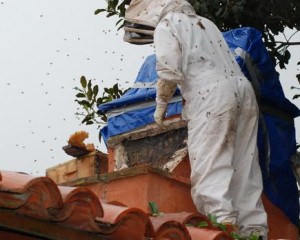The Great Bee Rescue
Upon learning our home of so many years was probably going to make it through an escrow, dependent in part on the removal of our extended bee family living in an unused chimney, I began contemplating how I was going to get them out alive-Alive and well enough to live for anther day or more. You see, I am one of those strange people who value bees and do not see them as public enemy #1 and in need of extermination whenever they are seen in an abundance of over five on a 50×100 sq. ft lot. I am no fan of our local “pest” control companies, which to my dismay, not only include bees in this category, but spiders.
After making some calls to local “live removal” bee exterminators and even having two come out to view the situation, I became suspicious enough to start educating myself as to this “live removal” business prattle. It turns out that the live removal is by way of vacuums – very powerful vacuums- and few survive the ordeal. So now what? Next step, consult Master Gardener Association. It suggested I contact the local Beekeeper Association. Voila!

The bee hive is moved from the chimney.
This is one amazingly dedicated and informed group. Within a week, I had three people interested in removing my bees to a temporary hive. Each came out and described how they would do the job. I had really warm and fuzzy feelings about all of them. I went with the one who could do the job before my escrow deadline. On the big day, rain was forecast. And this time it was accurate.
Terrific! This meant that more of the bees would be home rather than out working like good little bees love to do. Removing the comb, eggs and queen to the new hive was going to be much more difficult. Gaining access to the chimney without demolishing the whole thing was the other challenge. I contacted our Master Craftsman, Francisco, who has been with us since our remodel in 1991. With some serious arm twisting and the promise of a bee suit, he agreed to carefully pry off the tiles for my clients. I didn’t tell him about the rain forecast.
Everyone arrived ahead of time and began their duties. We were all pretty excited and “up” with the possible exception of Francisco. First, Veronica and Alyssa, the bee keeper association reps, prepared the comb holders for the new hive. Second, they began making smoke and then donned the bee suits. The kindling was getting wetter by the minute (leaves and bark from the yard and wood pile). But the resultant smoke set every one at ease with the knowledge that it would settle the bees down. The keepers pretty much pooh-poohed the Africanized concept as so much misinformation. There has been so much interbreeding since their arrival here that the general tameness of the bee populations has been restored. I can personally attest that the bees on my little green acre are quite unconcerned about my presence and go on about their business as I putz around in their foraging grounds.
The third order of business was to get the temporary hive up on the roof and level it. The area was smoked as a precaution. With that done, Francisco went up to dismantle to chimney area where we knew the hive to be. When no angry swarming occurred we all settled down. With the hive exposed, the girls began the removal of the comb as we passed up new smoke dispensers. Knives were used to separate long extensions of it. Each section was placed in the new hive along with accompanying bees that were present. At last the egg “room” was found and also removed to the new hive. The Queen was not located but she may have escaped notice in all the moving. New queens are often introduced in hives like this, so it was not of great concern. With the box filled to capacity with honey comb, the rest was bagged and handed down the ladder. We all had to have a taste or two (well, mouthfuls). It was wonderful – a full flavor with a hint of eucalyptus scent.
Within two hours the job was done, the rain really turned on, and a spray that smells like almond oil which bees detest was applied to the old site. The chimney was covered with a heavy tarp and the edges sealed. Any returning bees would not be able to get back into the old site and would instinctively go to the new hive by following their noses. Yes, they can smell!
Seven days later the new hive was removed to an organic nursery where it will remain until we are settled in our own new home. Yes, they are going to be our residents again!
They will become a part of a new habitat garden that is planned for the property. And hopefully they will remain in the hive box, rather than selecting a chimney or attic.
Category: Local News







